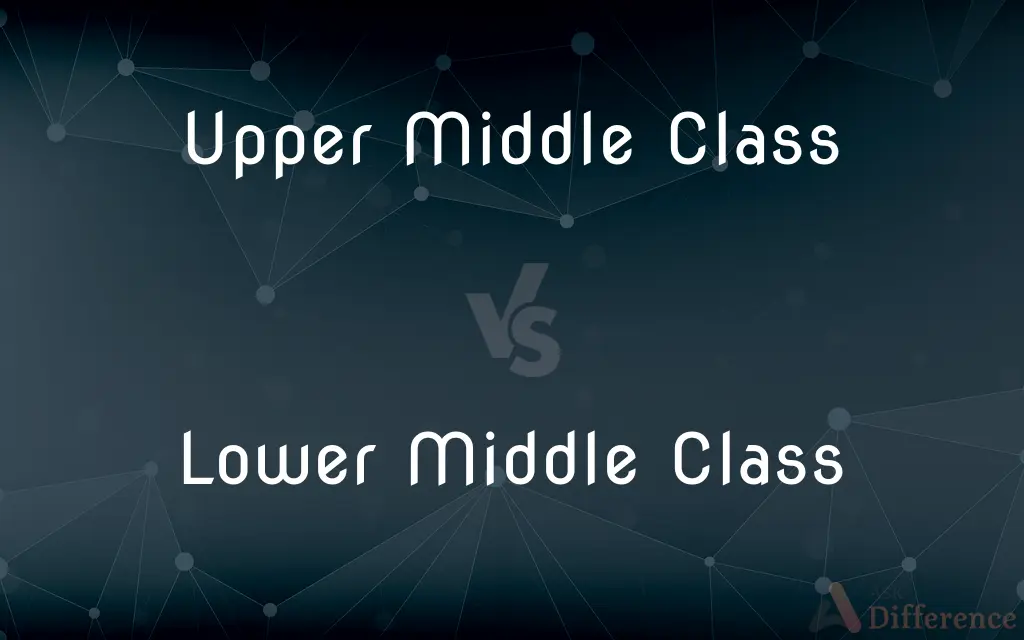Upper Middle Class vs. Lower Middle Class — What's the Difference?
By Tayyaba Rehman & Fiza Rafique — Published on February 3, 2024
Upper Middle Class refers to a socio-economic group with higher income, education, and occupational prestige than the Lower Middle Class, which has modest income and educational levels.

Difference Between Upper Middle Class and Lower Middle Class
Table of Contents
ADVERTISEMENT
Key Differences
The Upper Middle Class is characterized by a higher income bracket, often derived from professional and managerial careers. They typically have a comfortable lifestyle, with the ability to afford luxuries and save. In contrast, the Lower Middle Class usually has moderate income levels, stemming from semi-professional or skilled trades. Their lifestyle is more about meeting necessities with little room for luxuries.
Education is a distinguishing factor. Upper Middle Class individuals often have advanced degrees, facilitating careers in high-paying sectors. The Lower Middle Class might have some college education or trade qualifications, leading to moderately paying jobs.
In terms of assets, the Upper Middle Class usually owns significant assets like real estate and investments. They have a stable financial base. The Lower Middle Class, however, has fewer assets, and their savings are typically less, making them more vulnerable to economic downturns.
Social status and lifestyle vary significantly. The Upper Middle Class often has access to elite social networks and high-quality services, whereas the Lower Middle Class may have limited access to these networks and services.
The Upper Middle Class tends to have more opportunities for upward mobility due to their resources and connections. The Lower Middle Class may face more challenges in moving up the social ladder, often constrained by limited resources and opportunities.
ADVERTISEMENT
Comparison Chart
Income Levels
High income, often from professional jobs
Moderate income, from semi-professional jobs
Education
Advanced degrees, higher education
Some college or trade qualifications
Assets
Significant assets, real estate, investments
Fewer assets, limited savings
Lifestyle
Comfortable, can afford luxuries
Focused on necessities, fewer luxuries
Social Mobility
Greater opportunities for upward mobility
More challenges in moving up socially
Compare with Definitions
Upper Middle Class
Individuals with significant assets and investments.
In the Upper Middle Class neighborhood, most own their homes.
Lower Middle Class
Individuals with some college education or trade qualifications.
Many in the Lower Middle Class have associate degrees or trade certifications.
Upper Middle Class
A socio-economic group with high income and professional careers.
The Upper Middle Class family often vacations in Europe.
Lower Middle Class
A group with moderate income from skilled or semi-professional jobs.
The Lower Middle Class family works hard to maintain their modest home.
Upper Middle Class
People with advanced education and managerial roles.
The Upper Middle Class couple both hold executive positions.
Lower Middle Class
People with fewer assets and limited savings.
The Lower Middle Class couple saves diligently for their child's education.
Upper Middle Class
A class with access to elite social networks.
Their Upper Middle Class status afforded them exclusive club memberships.
Lower Middle Class
A class focused on meeting necessities rather than luxuries.
The Lower Middle Class budget is primarily for essentials, not extravagances.
Upper Middle Class
Those enjoying a comfortable lifestyle with luxuries.
The Upper Middle Class family drives luxury cars and dines at fine restaurants.
Lower Middle Class
Those facing more challenges in social mobility.
Despite their efforts, the Lower Middle Class family struggles to climb the social ladder.
Upper Middle Class
Occupying the upper part of the middle socioeconomic range in a society
Lower Middle Class
Occupying the lower part of the middle socioeconomic range in a society.
Lower Middle Class
Occupying the lower part of the middle socioeconomic range in a society
Common Curiosities
What are typical characteristics of the Lower Middle Class?
The Lower Middle Class usually has modest incomes, intermediate education levels, and often holds clerical or blue-collar jobs.
Is home ownership a factor in these classifications?
Yes, Upper Middle Class individuals are more likely to own homes in affluent areas, while Lower Middle Class individuals may own or rent in less expensive areas.
What defines the Upper Middle Class?
Higher income levels, advanced educational degrees, and professional or managerial occupations typically define the Upper Middle Class.
Are there differences in health care access?
Yes, the Upper Middle Class often has better access to health care and can afford higher-quality care than the Lower Middle Class.
Do these classes have different educational opportunities?
Generally, the Upper Middle Class has access to higher-quality education and resources, while the Lower Middle Class may have more limited educational opportunities.
How does lifestyle differ between these classes?
The Upper Middle Class often affords a more comfortable lifestyle with greater discretionary spending, while the Lower Middle Class lifestyle is more budget-conscious.
How do leisure activities differ between these classes?
The Upper Middle Class tends to engage in more expensive leisure activities, while the Lower Middle Class often opts for more affordable or local options.
Can individuals move between these classes?
Yes, though challenging, individuals can move between classes through changes in education, income, or career advancement.
How does the perception of these classes vary culturally?
Cultural perceptions vary, but generally, the Upper Middle Class is seen as more affluent and influential, while the Lower Middle Class is viewed as hardworking but with fewer resources.
How do these classes impact social mobility?
The Upper Middle Class typically has more opportunities for upward mobility due to resources and connections, compared to the Lower Middle Class.
Does the type of employment differ?
Yes, Upper Middle Class individuals often hold higher-ranking, professional jobs, while Lower Middle Class individuals may work in skilled trades or clerical positions.
How does the social network differ between these classes?
The Upper Middle Class tends to have a more extensive and influential social network, while the Lower Middle Class may have a smaller, more localized network.
Are there differences in political influence?
The Upper Middle Class generally has more political influence due to higher economic status and social connections than the Lower Middle Class.
How does financial security differ between these classes?
The Upper Middle Class typically enjoys more financial security and savings, whereas the Lower Middle Class may experience more financial instability.
Is there a difference in consumer behavior?
Yes, the Upper Middle Class often spends on luxury or higher-end products, while the Lower Middle Class is more likely to seek value and practicality in purchases.
Share Your Discovery

Previous Comparison
B.M.S. vs. B.B.A.
Next Comparison
DSP vs. MicroprocessorAuthor Spotlight
Written by
Tayyaba RehmanTayyaba Rehman is a distinguished writer, currently serving as a primary contributor to askdifference.com. As a researcher in semantics and etymology, Tayyaba's passion for the complexity of languages and their distinctions has found a perfect home on the platform. Tayyaba delves into the intricacies of language, distinguishing between commonly confused words and phrases, thereby providing clarity for readers worldwide.
Co-written by
Fiza RafiqueFiza Rafique is a skilled content writer at AskDifference.com, where she meticulously refines and enhances written pieces. Drawing from her vast editorial expertise, Fiza ensures clarity, accuracy, and precision in every article. Passionate about language, she continually seeks to elevate the quality of content for readers worldwide.













































